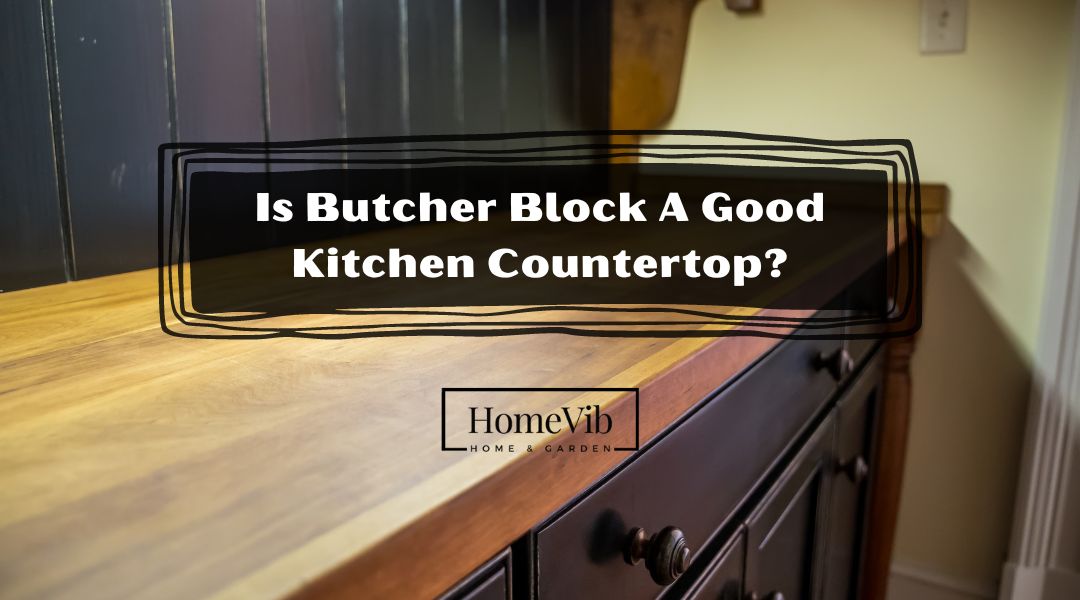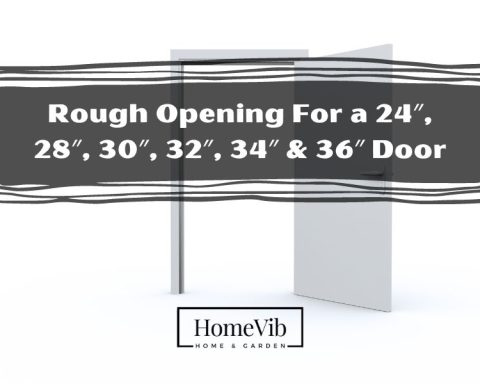Butcher block is becoming more and more popular as a kitchen countertop choice. But is it a good choice?
First, we’ll look at what makes up a good butcher block. At the same time, we will discuss its advantages and disadvantages in your kitchen.
Currently, Butcher block is an alternative material to solid wood countertops. They consist of stable quality hardwood, which means they can hold up and last for a long time.
There’s no doubt that butcher block gives a feeling of solidity. Not only that, but it also provides safety to the kitchen area.
Butcher Block is a good kitchen countertop since it is durable and will last a lifetime. You can rely on their excellent features, such as versatility and heat resistance. Moreover, it offers a flat working surface that will not damage sharp tools. This eliminates the need to re-edge and re-sharpen knives and cleavers frequently. To cap it all off, it is easy to clean and maintain.
Is Butcher Block A Good Choice For Kitchen Countertops?

Yes, Butcher block is a good choice for kitchen countertops.
It’s long-lasting and built to last a lifetime. Butcher blocks have great qualities like adaptability and tolerance to high temperatures.
In addition, it provides a level surface that is safe for use with sharp tools. Plus, it’s low-maintenance and simple to clean up afterward.
Butcher block tops are the perfect choice if you need a surface for various purposes. It is sturdy enough to withstand a busy kitchen’s daily usage conditions. Moreover, they are more sturdy than other tabletop materials like granite.
These wood countertops are one of the more reasonably priced counter options. They are less pricey than natural stone countertops. Also, you may customize the wood to meet your budget.
What Is Butcher Block?
A butcher block is a specific wood surface used for tables and worktops. They are almost the same actual cutting surfaces used in meat processing industries. It’s common to refer to the butcher block as a chopping block, and it’s usually thicker than an inch or two.
Butcher Block Applications
It’s multipurpose, so you can use it for everything from worktops to kitchen islands. At the same time, you can apply it to coffee tables and dining tables.
Butcher Block Countertops Pros And Cons
Before installing butcher block countertops, evaluate first their pros and cons. But first, let’s discuss the advantages and benefits it provides.
Pros
Cheap Wood Material
Regarding kitchen counters, butcher block is one of the budget-friendly options. It is possible to save even more cash by performing the installation yourself.
Wood Durability
The most common durable types of woods are oak, cherry, walnut, and maple. In addition, they also come in a variety of grain patterns. These include edge grain, end grain, and mixed.
Warm Appeal
Butcherblock countertops will make those spaces even more inviting. So when you incorporate it into your kitchen, you can achieve that warm and welcoming vibe.
Long Life span
If you treat butcher blocks with care and maintenance, they can survive for up to 20 years. Consequently, they will endure far longer than standard laminate countertops.
Easy Maintenance
Cleaning and caring for butcher blocks is a breeze. You can use one or two coats of mineral oil appropriate for food to cleanse the Butcher block.
Cons
As important as it is to learn the positive sides, it is crucial to understand the disadvantages too.
Prone to Scratches
Compared to hard surfaces like marble or tile, wood for countertops is softer. That’s why butcher block counters quickly get scratches and marks.
Susceptible To Water Damage
Temperature change causes expansion and contraction in wood, much as it does in water. Therefore, butcher block countertops are susceptible to water damage.
Not Heat Resistant
Putting something hot on the butcher block will leave a burn mark, and you will have to refinish the wood.
Cracks And Seasonal Changes
Seasonal fluctuations in humidity cause the wood to expand. Thus, it if contracts, it causes the wood material to shift.
What Types Of Wood Are Used For Butcher Block?
These are some of the common wood types that homeowners use to construct a butcher block:
- Maple
- Timber
- Cherry
- Wenge
- Walnut
- Birch
- Teak
- Beech
- Bamboo
Let us identify each one.
Maple
The most common type of wood used for butcher blocks is maple. In contrast, others prefer Brazilian cherry or walnut as great alternatives.
Timber
Some homeowners also explore Timbers wood from the depths of Lake Superior. For them, these are stunning butcher blocks of color that transform the space.
Wenge
A wenge wood top with a Durata finish is another option. Indeed, it can be the most eye-catching part of the cooking space. It’s perfect for daily breakfasts and buffets.
Cherry
Butcher blocks made of cherry wood are gaining in popularity. It may not be ideal for cleaving large pieces of meat. However, it serves its purpose effectively for jobs like cutting and chopping.
Walnut
Walnut is stunning, but they aren’t as practical as those made from maple. For instance, because of their medium grain, they tend to absorb water.
Birch
Solid hardwood furniture made from birch is an excellent investment. This provides strength and longevity. In addition, the fine grain and light shade of birch wood makes it an ideal choice for butcher blocks.
Teak
Teak is more resistant to dents than walnut but more resistant to beech or maple. It is also naturally water-resistant thanks to its high oil content and rich, warm tone.
Beech
Beech is scratch and dent-resistant without being so tough that they dull knives. Because of its tight grain, this wood is ideal for cutting boards and butcher block counters.
Bamboo
Chopping boards made of bamboo are long-lasting and won’t scrape or dent easily. The density and softness of its construction are an ideal balance.
How Much Do Butcher Block Countertops Cost?
Depending on the type of wood you select, butcher block might cost anywhere from $30 to $40 per square foot.
Countertop space ranges from 30 to 40 square feet in traditional kitchens. Meanwhile, it ranges from 50 to 60 square feet in contemporary ones. The price of installation incorporates the final quote by the contractor.
Regular labor: Regular installation can cost as much as $70 per sqft.
Premium labor: Butcher blocks can cost upwards of $200 per sqft. This makes them more expensive than concrete surfaces.
Large kitchens
Incorporating pricey hardwoods into a large kitchen project may range as high as $10,000.
Customization Work
Depending on the design’s complexity, a custom job’s price might range from $200 per square foot to $15,000.
Material
There is a $100-$250 price range for the materials and resources needed to complete the job. This category includes tools, caulk, sealants, adhesives, and cleaning products.
Fabrication
You’ll need an electric saw or a router to cut out the wood for the sinkholes and route the board. Moreover, you also need oil and stain. These will make another $320 in costs for your budget.
Backsplash
You can find Butcher block backsplashes for around $1,500. Typically, you can buy backsplashes separately from the rest of the kitchen.
Are Butcher Block Counters Durable?
Yes, Butcher block counters are durable. Of course, we all know that Butcher blocks consist of wood. For that reason, wood countertops maintain high quality and durability across the globe.
That’s why these woods can handle extreme climates. It is dependable since you can use it for indoor and outdoor applications. You can always apply it in both tropical and temperate climates.
Tensile Strength of Wood
Wood’s tensile stress capability in flexure can range from around 500 psi to about 2500 psi. Naturally, higher psi signifies a greater strength and, thus, a higher price. However, the greater strength of these woods also makes them more resilient.
Hardness of Wood
Density, or a wood’s weight per unit volume, is a fair measure of its durability. As a rule of thumb, a higher ratio indicates denser and stronger wood.
Reputable Wood Resources
When shopping for butcher wood, it’s crucial to research the manufacturer. Then learn about the oil or finish it goes with. The final coating makes a huge impact on usability. Since wood has natural movement, you may get a Pringle-shaped countertop. So you better check the moisture level and picks high-quality boards.
Are Butcher Block Countertops High Maintenance?
Yes, butcher block countertops require more upkeep than other kitchen counters.
As you can see, butcher block countertops are not waterproof. Therefore, you should take extra precautions to protect them from spills and stains. One way to accomplish this is to use oils and finishes that assist the countertop. It absorbs the moisture it needs while keeping water vapor out.
Follow these guidelines to keep your butcher block in pristine condition.
Clean And Sanitize
While cutting right on the surface may be convenient, doing so will result in stains. To clean, gently scrape any stuck-on debris with a spatula. Then use a damp towel to wipe the surface with mild dish soap and water.
Apply Mineral Oil
A butcher block countertop requires mineral oil to keep the board from cracking. It also provides the right moisture level.
Clean with Vinegar
White vinegar used with a dishcloth provides a more thorough washing. For best results, let the vinegar sit for 15 minutes. This is to allow the antibacterial properties to activate entirely. Then wipe down with a fresh damp towel or sponge.
Repairing A Crack
You should contact a professional should if a significant crack appears. Otherwise, you can apply DIY. Cover the break using wood glue that is suitable for use around food, and let it dry. Get rid of the crusted-on adhesive by sanding it down, then polish it.
Can You Put Hot Pans On Butcher Block Countertops?
No, you can’t place hot pans on the butcher block because it will develop burn and frayed marks.
Putting a hot cast-iron pan down on a maple butcher can cause severe damage to the surface. Remember, though, that you can fix it with a Beeswax and orange oil finish. You can also remove some of the scratches with some sandpaper.
Using Trivets and Heat Mats
Use pads or trivets with hot pots since wood countertops are not heat-resistant. Remember that severe dryness can cause cracking. Therefore, direct heat will cause the wood to expand on your counter. Additionally, this would make your wood seem horrible and unsuitable for the kitchen.
Apply The Right Treatment Substance
Make sure your butcher block countertop has been properly treated. You should apply the right treatment before buying, installing, and using it.
Overall, you can damage the wood countertops with direct contact with heat appliances. These include microwaves, dishwashers, and stovetops. These appliances generate a lot of heat that might harm your countertop.
How Do You Seal a Butcher Block Countertop To a Kitchen Sink?
You can seal a butcher block countertop to a kitchen sink by applying a Waterlox finish.
Waterlox is food safe. It does get scratched and dinged, so you should be ready for a certain amount of patina.
Here are some of the steps that you can follow:
Step 1: Cut Butcher Block
Cut the butcher block down to size by slicing the Masonite to the board’s width.
Step 2: Join the Butcher Block
Use tite joint fasteners to attach the corners. Then use a drill bit to the holes at regular intervals. Next is to mark a straight line to join the holes.
Step 3: Glue the Joints
As a third step, glue the joints using a sponge. Next, use a spatula to apply adhesive along the freshly sawn wood swiftly.
Step 4: Mount the Sink
Mark the sinkhole by clamping a piece of plywood over the top of the sink. Then use a router to smooth down the rough edges.
Step 5: Finish the Counter
As a final step, use Waterlox finishing. To ensure adequate protection, you should apply multiple coats. This is because Waterlox soaks into the woods.
Overall, the ideal way to seal butcher block is with an overmount sink and a typical bead of silicone. Remember to apply it around the underside of the sink’s rim.
Even so, keeping the junction between the two materials takes work. So you might see some discoloration on the wood.









